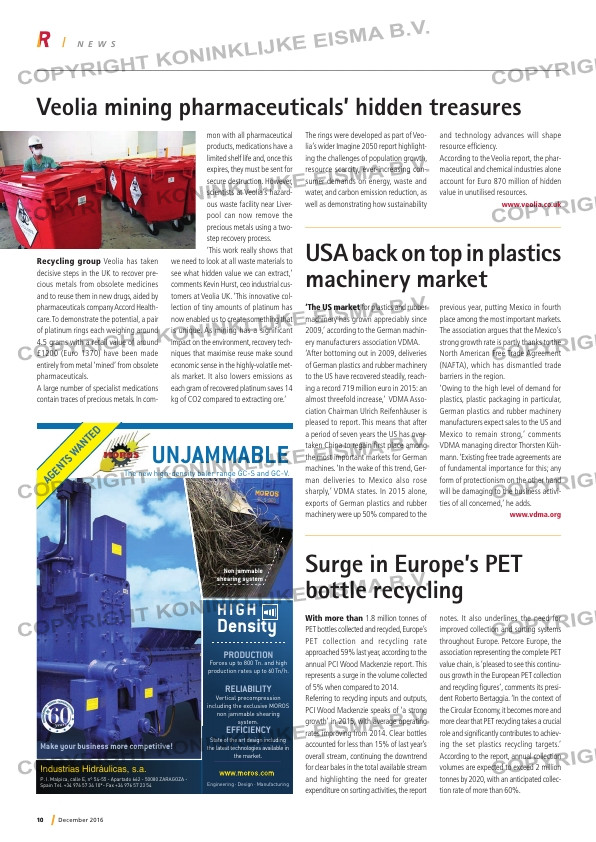Page 10 from: December 2016

10 December 2016
N E W S
Industrias Hidráulicas, s.a.
P. I. Malpica, calle E, nº 54-55 – Apartado 662 – 50080 ZARAGOZA –
Spain Tel. +34 976 57 34 10* – Fax +34 976 57 23 54
UNJAMMABLE
The new high-density baler range GC-S and GC-V.
H I G H
Density
PRODUCTION
Forces up to 800 Tn. and high
production rates up to 60 Tn/ h.
RELIABILITY
Vertical precompression
including the exclusive MOROS
non jammable shearing
system.
EFFICIENCY
State of the art design including
the latest technologies available in
the market.
Non jammable
shearing system
Engineering · Design · Manufacturing
Make your business more competitive!
AG
EN
TS
W
AN
TE
D
ORIGINALES Prensa GC-S GC-V
C
M
Y
CM
MY
CY
CMY
K
Veolia mining pharmaceuticals’ hidden treasures
Recycling group Veolia has taken
decisive steps in the UK to recover pre-
cious metals from obsolete medicines
and to reuse them in new drugs, aided by
pharmaceuticals company Accord Health-
care. To demonstrate the potential, a pair
of platinum rings each weighing around
4.5 grams with a retail value of around
£1200 (Euro 1370) have been made
entirely from metal ‘mined’ from obsolete
pharmaceuticals.
A large number of specialist medications
contain traces of precious metals. In com-
mon with all pharmaceutical
products, medications have a
limited shelf life and, once this
expires, they must be sent for
secure destruction. However,
scientists at Veolia’s hazard-
ous waste facility near Liver-
pool can now remove the
precious metals using a two-
step recovery process.
‘This work really shows that
we need to look at all waste materials to
see what hidden value we can extract,’
comments Kevin Hurst, ceo industrial cus-
tomers at Veolia UK. ‘This innovative col-
lection of tiny amounts of platinum has
now enabled us to create something that
is unique. As mining has a significant
impact on the environment, recovery tech-
niques that maximise reuse make sound
economic sense in the highly-volatile met-
als market. It also lowers emissions as
each gram of recovered platinum saves 14
kg of CO2 compared to extracting ore.’
The rings were developed as part of Veo-
lia’s wider Imagine 2050 report highlight-
ing the challenges of population growth,
resource scarcity, ever-increasing con-
sumer demands on energy, waste and
water, and carbon emission reduction, as
well as demonstrating how sustainability
and technology advances will shape
resource efficiency.
According to the Veolia report, the phar-
maceutical and chemical industries alone
account for Euro 870 million of hidden
value in unutilised resources.
www.veolia.co.uk
USA back on top in plastics
machinery market
‘The US market for plastics and rubber
machinery has grown appreciably since
2009,’ according to the German machin-
ery manufacturers association VDMA.
‘After bottoming out in 2009, deliveries
of German plastics and rubber machinery
to the US have recovered steadily, reach-
ing a record 719 million euro in 2015: an
almost threefold increase,’ VDMA Asso-
ciation Chairman Ulrich Reifenhäuser is
pleased to report. This means that after
a period of seven years the US has over-
taken China to regain first place among
the most important markets for German
machines. ‘In the wake of this trend, Ger-
man deliveries to Mexico also rose
sharply,’ VDMA states. In 2015 alone,
exports of German plastics and rubber
machinery were up 50% compared to the
previous year, putting Mexico in fourth
place among the most important markets.
The association argues that the Mexico’s
strong growth rate is partly thanks to the
North American Free Trade Agreement
(NAFTA), which has dismantled trade
barriers in the region.
‘Owing to the high level of demand for
plastics, plastic packaging in particular,
German plastics and rubber machinery
manufacturers expect sales to the US and
Mexico to remain strong,’ comments
VDMA managing director Thorsten Küh-
mann. ‘Existing free trade agreements are
of fundamental importance for this; any
form of protectionism on the other hand
will be damaging to the business activi-
ties of all concerned,’ he adds.
www.vdma.org
Surge in Europe’s PET
bottle recycling
With more than 1.8 million tonnes of
PET bottles collected and recycled, Europe’s
PET collection and recycling rate
approached 59% last year, according to the
annual PCI Wood Mackenzie report. This
represents a surge in the volume collected
of 5% when compared to 2014.
Referring to recycling inputs and outputs,
PCI Wood Mackenzie speaks of ‘a strong
growth’ in 2015, with average operating
rates improving from 2014. Clear bottles
accounted for less than 15% of last year’s
overall stream, continuing the downtrend
for clear bales in the total available stream
and highlighting the need for greater
expenditure on sorting activities, the report
notes. It also underlines the need for
improved collection and sorting systems
throughout Europe. Petcore Europe, the
association representing the complete PET
value chain, is ‘pleased to see this continu-
ous growth in the European PET collection
and recycling figures’, comments its presi-
dent Roberto Bertaggia. ‘In the context of
the Circular Economy, it becomes more and
more clear that PET recycling takes a crucial
role and significantly contributes to achiev-
ing the set plastics recycling targets.’
According to the report, annual collection
volumes are expected to exceed 2 million
tonnes by 2020, with an anticipated collec-
tion rate of more than 60%.



